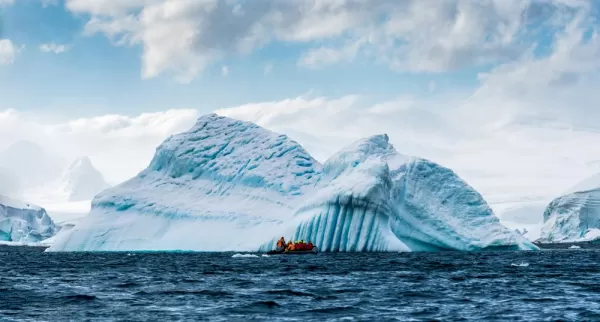The Strait of Magellan is a 350-mile/570 km channel separating the mainland of South America from the large Isla Grande de Tierra del Fuego and connecting the Atlantic and Pacific Oceans. It was first navigated by the explorer Ferdinand Magellan during his circumnavigation voyage in 1520. He named it the Strait of All Saints because his transit started on November 1, All Saints Day. Magellan named the southern island Tierra del Fuego after seeing the smoke from fires in the camps of the native Yahgan people, whom he called the Patagones, meaning “big feet,” and their land Patagonia. The strait is between two and 20 miles wide, earning the nickname Dragon’s Tail among sailors for its tortuous path.
Along with the Beagle Channel, it was one of two protected channels for sailing between the oceans before the construction of the Panama Canal. The third alternative was the notoriously turbulent open-ocean Drake Passage beyond Cape Horn. One sizeable port city in the strait, Punta Arenas, Chile, has an interesting harbor breakwater consisting of two ship hulks, the Cavenga, and an old iron four-mast sailing ship, the County of Peebles. Several Chilean national parks and monuments are in the strait, including Los Pinguinos National Monument and a sanctuary for protecting humpback whales. Southern right whales are also known to frequent the strait’s waters. There are 41 light signals in the strait, including the San Isidro Lighthouse, which has been restored and is now a museum, and the Evangelistas Lighthouse at the western entrance. The strait was difficult for sailing ships due to unpredictable winds and tidal currents. Depending on tide conditions, even modern ships often opt for one of the alternative routes because the Venturi effect greatly exaggerates the tidal speeds through narrows.
Punta Arenas is the most important port and commercial center for Chile's immense Patagonian agricultural area. The economy revolves around the sheep raised on the expansive pampas. Located on the Strait of Magellan, separating the mainland from the island of Tierra del Fuego, the city proclaims itself the southernmost city in the world. Its colonial history may be explored in the splendid Plaza de Armas, in the magnificent tombs of the Pioneer Cemetery, and in the opulent Braun-Menendez Mansion. Ferdinand Magellan's exploration heritage can be recaptured at the Nao Victoria ship museum. Fort Bulnes National Monument memorializes the earliest colonial period, while the offshore Los Pinguinos Natural Monument preserves the thriving seabird and sea lion colonies around Magdalena Island. This is also the port from which a full-day flight excursion takes visitors to the majestic peaks and picturesque lakes and wildlife of the Torres del Paine National Park.
Included Magdalena Penguin Reserve Experience
Upon arrival at Magdalena Island, declared a Natural Monument in 1982, you will see one of the largest penguin colonies in southern Chile, and get acquainted with the unspoiled habitat of penguins, cormorants and many other birds. A substantial colony of Magellan penguins nests and breeds here. These penguins return every year to this spot between October and March to lay eggs and raise their young. They bury their eggs in the sandy burrows and under shrubs; at this time of year most of the chicks will have hatched. The animals are naturally curious and untamed; if approached too quickly they will scamper into their burrows or try to reach the water.
A snack pack will be provided.
After ample time to observe the birds it is time for the invigorating walk back to the vesel and the navigation back to Punta Arenas. You will have about one hour on the island to observe the curious and entertaining penguins before returning to Punta Arenas.
Notes: Do not attempt to touch the penguins as their strong beaks can inflict serious wounds. Since this is a wildlife reserve, no visitor facilities are available. Walking is on mostly flat, marked pathways with approximately 30 minutes on uneven terrain. Wear sturdy, comfortable walking shoes.Rough sea conditions can be experienced on the approximately two hour journey to Magdalena Island; passengers prone to seasickness should take this into consideration It is essential that you wear warm layered clothing in order to fully enjoy and participate in this excursion. Seasonal migration, which is somewhat unpredictable, can affect the operation of this tour from March to April. The ship will liaise with the tour operator prior to arrival in Punta Arenas and, in the event that the penguins are no longer present, guests will be given the chance to substitute an alternative shore excursion.
Included Voyage Into the Past: Magellan's Discovery Experience
Only 18 members survived Magellan's 1519 expedition, which circumnavigated the globe and put Tierra del Fuego on the map. The territory you'll cover today played a significant role in Magellan's epic voyage, and your outing will introduce you to the saga and the first inhabitants of Fireland (Tierra del Fuego). Your guide will first show you some points of interest in Punta Arenas, the southernmost city in the world, but the major highlights are found in the rugged, scenic beauty outside of the city. You will head to Nao Victoria Museum, which contains a life-size replica of Ferdinand Magellan's ship -- the vessel in which he circumnavigated the globe. The ship replica recreates all the original structural features and, unlike many museums, offers a very tactile experience, as visitors are encouraged to hear the sounds of yesteryear and touch the replica everyday objects, including navigation instruments and artillery. The next stop is at the Maggiorino Borgatello Museum, founded by Salesian missionaries. This facility provides a comprehensive overview of the regional flora and fauna, the habitat of the local indigenous people, and regional history. From here, you will drive to the Cerro la Cruz viewpoint and take in the same view of the Strait of Magellan that Ferdinand Magellan himself had when he was here. You'll also see the port and the legendary Tierra del Fuego Island -- known as Fireland. On your way back to town, stop at Plaza de Armas (the main square) before returning to the pier.
Please note: You must climb a long flight of stairs to reach some of the displays at the Maggiorino Borgatello Museum and most of the exhibit interpretive panels are written in Spanish only.'
Included Punta Arenas on Foot Experience
Discover the frontier spirit of Punta Arenas, the largest city in southern Patagonia. Meet your in guide and walk to the Ancud monument which is dedicated to the schooner that carried the first settlers here in 1843. Stop at the historic pier to see a large colony of cormorants and observe the interesting behavior of these aquatic birds. Head toward the city center along the pleasant Colón Avenue, where you will find several neoclassical mansions including the Municipal Theater, the Braun Menéndez Museum and the Sara Braun Palace-each a reminder of the wool boom that brought business and immigrants here at the turn of the 20th century. Arrive at Plaza de Armas to see the monument to Ferdinand Magellan, the explorer who first sailed these waters, and walk the buidings around the plaza such as Union Club or the Cathedral and have free time. Climb to the Cerro de la Cruz observation deck for panoramic views of the city before returning to the ship.
Please note: It is essential that you wear warm, layered clothing in order to fully enjoy and participate in this excursion. Outer layer should be waterproof and windproof. Bring gloves, a warm hat and a scarf. You must climb a long flight of stairs to reach some of the displays at the Maggiorino Borgatello Museum and most of the exhibit interpretive panels are written in Spanish only.
























































